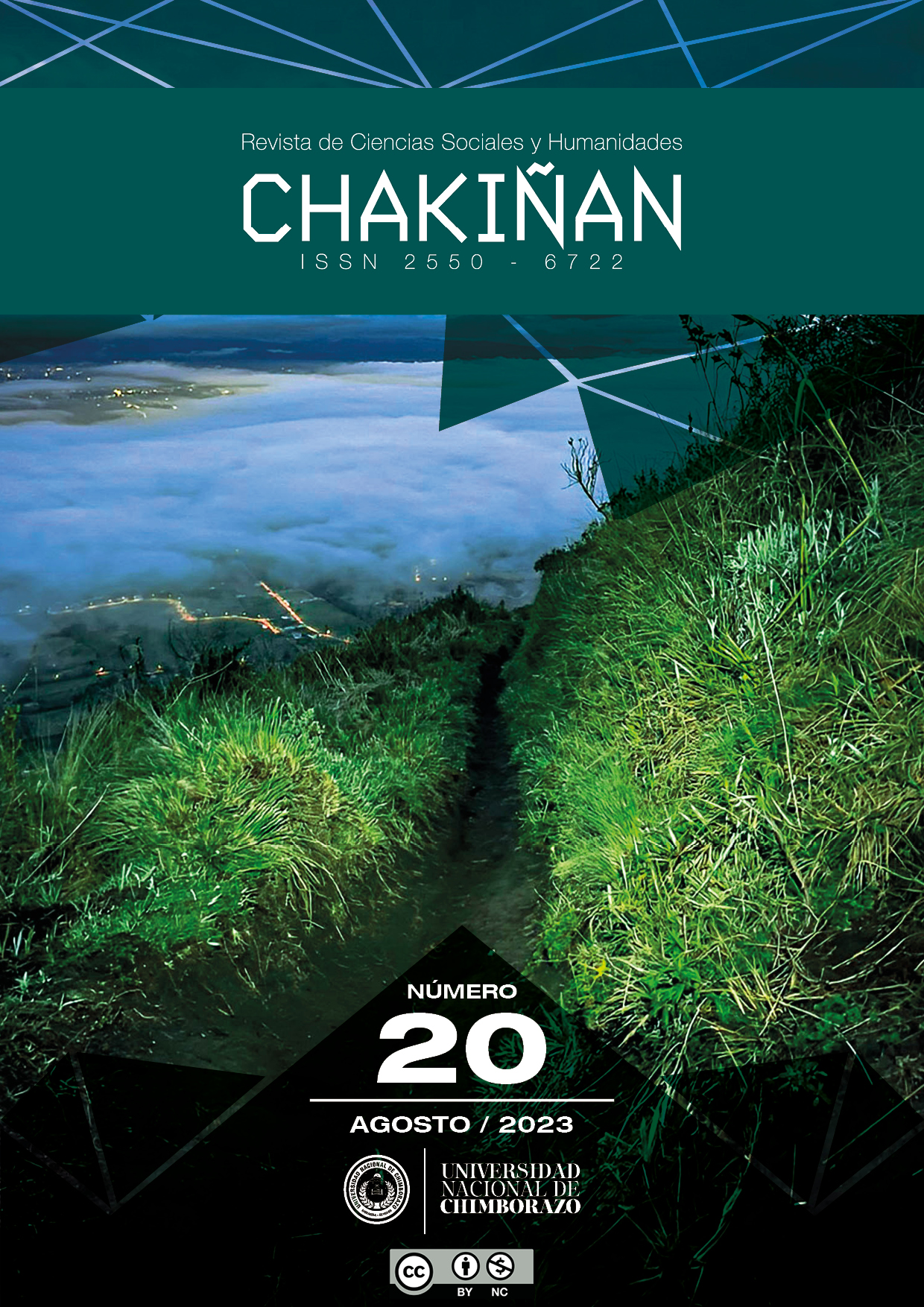CONTENT AND LANGUAGE INTEGRATED LEARNING (CLIL) TO DEVELOP WRITING SKILLS IN ENGLISH
Contenido principal del artículo
Resumen
In a world of permanent change, traditional language teaching methods do not solve the communicative needs in foreign languages that favor knowledge and adaptation to changing educational contexts. The CLIL method is widely used to develop skills both in the learning language and in other areas of knowledge, it allows for the strengthening of teaching capacities to assume the teaching of contents of the different subjects in a foreign language. The objective of this bibliographic review is to collect significant and existing information on the CLIL method and contribution of this method in the educational field. The documentary descriptive approach of recent research related to the subject of study is used, based on the theoretical foundations of bilingual education. The literature review shows that by teaching the foreign language as a vehicle to instruct content from other subjects, students understand the need to learn the language to seize the knowledge of the subject and allows teachers to explore their own teaching context, reflect and identify factors that can improve their teaching practice, especially in the inclusion of writing activities in English.
##plugins.themes.bootstrap3.displayStats.downloads##
Detalles del artículo
Número
Sección

Esta obra está bajo una licencia internacional Creative Commons Atribución-NoComercial 4.0.
Responsabilidad de los autores:
Son responsables por las ideas y datos recogidos en los manuscritos, por la fidelidad de la información, por la corrección de las citas, por los derechos para publicar cualquier material incluido en el texto y por la presentación del manuscrito en el formato requerido por la Revista (plantilla word). Un manuscrito enviado a CHAKIÑAN no debe estar publicado con anterioridad, ni haber sido presentado en la misma forma a otro medio de publicación.
Derechos de Autor:
Los artículos publicados no comprometen necesariamente el punto de vista de la REVISTA CHAKIÑAN. La Revista se alinea a la política de la licencia de Creative Commons Reconocimiento-No comercial 4.0 Internacional (CC BY-NC 4.0). Cada autor conserva el derecho sobre el artículo publicado en Chakiñan.
Declaración de privacidad
Los datos personales y las direcciones de correo electrónico introducidos en esta revista se usarán, exclusivamente, para los fines declarados por la publicación y no estarán disponibles para ningún otro propósito u otra persona.
Cómo citar
##plugins.generic.shariff.share##
Referencias
Alegre, L. (2021). Aprendizaje integrado de contenido y lengua extranjera para la enseñanza comunicativa de inglés académico. Revista Arbitrada Interdisciplinaria Koinonía, 6(4), 125-143. https://doi.org/10.35381/r.k.v6i4.1440
Argudo, J., Abad, M., Fajardo, T., & Cabrera, P. (2018). Analyzing a Pre-Service EFL Program through the Lenses of the CLIL Approach at the University of Cuenca-Ecuador. Latin American Journal of Content & Language Integrated Learning, 11(1), 65-86. https://dspace.ucuenca.edu.ec/bitstream/123456789/35843/1/documento.pdf
Barre, P., & Villafuerte, J. (2021). English as a Foreign Language Instruction in Ecuador: Implementation of the Content and Language Integrated-Learning during 2019-2021. English Language Teaching Educational Journal, 4(2), 99-112. https://eric.ed.gov/?id=EJ1311546
Campillo, M. (2017). CLIL methodology in Physical Education classes for bilingual teaching. Lecturas de Educación Física y Deportes, 22(235), 47-51. https://efdeportes.com/efdeportes/index.php/EFDeportes/article/view/54
Cancelas, L. P., & Cancelas, M. Á. (2009). AICLE: estableciendo las bases para trabajar la música en L2. Tavira. Revista Electrónica de Formación de Profesorado en Comunicación Lingüística y Literaria, 1(25), 137-159. https://rodin.uca.es/handle/10498/10704
Cendoya, A., Di Bin, V., & Peluffo, M. (2008). CLIL Content and Language Integrated Learning. Puertas Abiertas, 4(4), 65-68. https://www.memoria.fahce.unlp.edu.ar/art_revistas/pr.4558/pr.4558.pdf
Dávila, M., & Ramos, P. (2013). Design of a model workshop for the subject of social sciences in French of third grade of the integrated educational institution La Candelaria. Pontificia Universidad Javeriana.
Díaz, N. (2021). The CLIL experience of students belonging to the First Year of Secondary Education from a transitional perspective. RIDE. Revista Iberoamericana para la Investigación y el Desarrollo Educativo, 11(22), 1-19. https://doi.org/10.23913/ride.v11i22.864
Fajardo, T. M. F., Argudo, J., & Abad, M. (2020). Language and Teaching Methodology Features of CLIL in University Classrooms: A Research Synthesis. Colombian Applied Linguistics Journal, 22(1), 40-54. https://doi.org/10.14483/22487085.13878
Fernández, A. (2001). A bibliographical selection on the CLIL method (Integrated Learning of Curricular Knowledge and Foreign Language). Contextos Educativos. Revista de Educación 1(4), 217-239. https://doi.org/10.18172/con.494
Griva, E., & Kaskivis, K. (2014). CLIL in primary education: posibilities and challenges for developing L2/FL skills, history understanding and cultural awareness. In N. Bakić-Mirić & D. Erkinovich, Current trends and issues in education: an international dialogue. Cambridge Scholars Publishing.
Lasagabaster, D. (2011). English achievement and student motivation in CLIL and EFL settings. Innovation in Language Learning and Teaching, 5(1), 3-18. https://doi.org/10.1080/17501229.2010.519030
Machado, J. (11 Dec 2019). Ecuador tiene el peor nivel de inglés de América Latina. Primicias. https://www.primicias.ec/noticias/sociedad/idioma-ingles-estudiantes-convenio-educacion-profesores/#:~:text=El%20resultado%20de%202019%20ubic%C3%B3,promedio%20es%20de%2023%20a%C3%B1os
Manzano, B. (2015). CLIL in three spanish monolingual communities: the examples of Extremadura, Madrid and La Rioja. ELIA, 1(15), 135-158. https://doi.org/10.12795/elia.2015.i15.07
Mariño, C. (2014). Towards implementing CLIL (content and language integrated learning) at CBS (Tunja, Colombia). Colombian Applied Linguistics Journal, 16(2), 151-160. https://doi.org/10.14483/udistrital.jour.calj.2014.2.a02
Marsh, D., Maljers, A., & Hartiala, A. (2001). Profiling european CLIL classrooms. Languages Open Doors. University of Jyväskylä.
Palma, S. (2020). Content and language integrated learning in ecuadorian public schools: an analysis of the teachers’ reality. Revista Cognosis, 5(2), 83-102. https://doi.org/10.33936/cognosis.v5i2.2017
Piacentini, V. (2021). CLIL and Science education. A review for a Language focus in Science teaching. Ricerche di Pedagogia e Didattica. Journal of Theories and Research in Education, 16(3), 113-131. https://rpd.unibo.it/article/view/12646
Rueda, M., & Wilburn, M. (2014). Theoretical approaches for the acquisition of a second language from the horizon of educational practice. Perfiles Educativos, 36(143), 21-28. http://www.scielo.org.mx/pdf/peredu/v36n143/v36n143a18.pdf
Salvador, C., Chiva, O., & Colomer, C. (2020). The effect of bilingual Physical Education on students’ Physical Activity. Things are not always as they seem. Cultura, Ciencia y Deporte, 15(43), 53-61. https://dialnet.unirioja.es/servlet/articulo?codigo=7282462
Villamarín-Guevara, J. E., & Fajardo-Dack, T. (2022). CLIL in use: perceptions and experiences of English teachers in public schools. CIENCIAMATRIA, 8(1), 513-541. https://doi.org/10.35381/cm.v8i1.688






